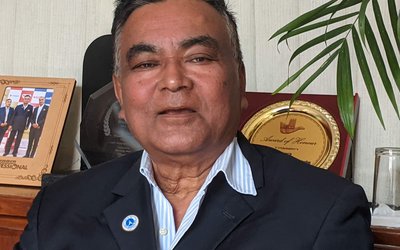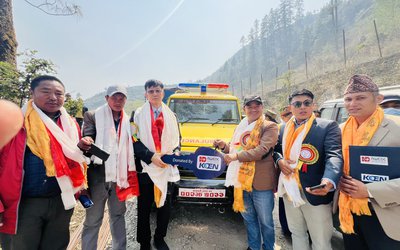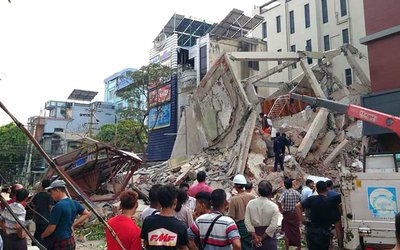
JALAN KUMAR SHARMA, Chief Executive Office of Sana Kisan Bikas Bank (Small Farmers Development Bank), is a well-known figure in the country's micro-finance sector. His experience of working in small farmers development project for over 40 years makes Sharma someone who preceded the work by Bangladesh's world renowned Mohammad Yunus on Grameen Bikas Bank. After successfully holding the first ever Farmer's Summit in Nepal, Sharma spoke to NEW SPOTLIGHT at his office. Excerpts of his interview:
You have recently concluded the first Small Farmers Summit. What message did the Summit deliver?
The small farmers were able to send a message at the national level that they can play in important role in poverty alleviation through agriculture development. The summit has created conducive environment for the promotion of small farmers. The summit has also opened the possibility to link small farmers with broader markets. Most importantly the summit called for solidarity among small farmers.
How do you evaluate its success?
The summit is very significant since it was for the first time the small farmers gathered in a small place, in 40 years of history. There were over 600 small farmers from 55 districts of Nepal. Farmers have also demonstrated some of their works done in various parts of Nepal.
How do you look at the development of small farmers over the years or, say, till the first summit?
By paying entry fees for participation, the farmers have shown that they are financially capable to attend a program in Kathmandu. Besides, the idea floated by small farmers regarding Nepal's agriculture process indicated that they have improved their quality of understanding. As a person working closely with small farmers, the logic, idea and experience shared by the small farmers have shown that they have the capability to make changes. This is very encouraging.
How do you evaluate the overall scenario?
Initially, the Small Farmers Development Program helped raise the awareness among the farmers. Small Farmers Development Project was guided under the management of Agriculture Development Bank. The early program was guided and mobilized by the employees of ADB. The employees were also responsible for the financial decision, including loan allocation. As it was run by employees, the program did not have a direct linkage to the community and it was too expensive to sustain as the employee deputed by ADB had a higher salary. However, the present movement is driven by the community through cooperatives.
What difference does this make then?
After running under direct management of Agriculture Development Bank, the bank decided to give the ownership to the people. In early days, it was completely managed by employees. Now it is under the control and command of the people living in the particular areas. Following the pullout of its employees by Agriculture Development Bank, turning the small Farmers Development Project into a Small Farmers Cooperatives, the new era began. Now Small Farmer Cooperatives have their own local employees, they are now under local staff. Now there has evolved some institutional mechanism at the local level to operate the cooperatives and one can see the emerging local institutions with their own local employees. Now local employees run the daily functions and leaders play the leadership role and give directives to the cooperatives. Thus, they are now more effective and efficient.
What is the status of the present set up?
Now Small Farmers Cooperatives are autonomous and independent. Many questions still remain unanswered: such as, what to do in case they fail to meet the target and collapse? What about irregularities and so on? However, the present scenario is that it is bringing better results, empowering the people at the grassroots level. As farmers are more knowledgeable about the pattern of agriculture than anybody else, they know where to spend money and how to spend it.
How effective will small farmer cooperatives be to alleviate poverty?
We have not made any study on the total impact of the small farmer cooperatives in poverty alleviation. What I can say, however, is that it has had definite impacts on that front. Almost 400,000 households are affiliated with us. We cannot claim that joining our cooperatives automatically reduces poverty. However, joining our cooperatives means one step ahead in the path to alleviative poverty. Along with taking loan, saving is another important component. Small farmers are saving good amount of money through the cooperatives. This is good news. The process of poverty alleviation begins with the amount of money a farmer saves. Our experiences are that there are many villages with large number of poor farmers. We have a target to meet the need and demand of poor.
Where do your cooperatives focus?
Our cooperatives are involved in financial and non-financial activities. Along with providing loan, cooperatives also get involved in sanitation and education campaigns, construction of drinking water taps, and so on.
What is the target of your bank?
Our target is to eliminate absolute poverty in ten years. Our target is to reach one million households of 70 districts by 2025. It will be around 4-5 million population. There will be more than 1000 small farmer cooperatives then. Now we have 366 cooperatives affiliated to us and another 100 are in the process of joining us. We are adding 40-50 cooperatives each year. Along with us there are many other cooperatives, Poverty Alleviation Fund and micro-credit institutions and community based organizations are also working in the area of poverty alleviation.
For the first time, you have brought the down trodden small farmers from remote parts of Nepal to five star hotels in Kathmandu, how do you look at this?
This is a good exposure for them. The participation of the farmers showed how small farmers are transforming themselves in the last 40 years as they happily joined the summit without any hesitation. This is good news. There are almost 1000 small farmers who came to take part in the summit. We took feedback of over 500 participants and their feedback is positive. As papers were presented in Nepali, our participants got enough opportunity to interact with experts. It was very relevant. We have tried to check whether our farmers were well aware of the debate or not. Small farmers also got the opportunity to know what the government policy is and how Nepal's development partners are supporting the government and so on or how much money donors are spending.
What are the eligibility criteria for being called small farmers?
The farmers who hold agriculture land less than one bigha in terai and less than 20 ropanis in hill are the main criteria to be called small farmers. This is on the basis of land holding. Another basis is income. If a person has a per capita income of less than Rs.20,000.00, we regard that person as a small farmer. We have made several definitions of small farmers since the inception of the idea. This is related to agriculture. Our studies have shown that overwhelming majority of the farmers are small farmers. There are a very few farmers in the country who hold more than two hectares of land. There is land but the agriculture land is very small. Fifteen years ago, there was no remittance flow like in the present times. We are now considering redefinition of small farmers. We are providing loans of up to Rs.200,000 without bank guarantees, but usually we are providing up to Rs. 500.000.00.
Since you have a long experience of working in the agriculture sector, how do you see the pattern of production and what is the level of production of small farmers?
One of the positive things is that the leadership is gradually going at the hands of farmers. Other important aspect is that even the youth are joining in agriculture. Each small farmer's cooperatives have up to 5000 membership. The productivity has gone up. The involvement of literate and educated people has increased. Farmers have diversified their investments. Along with vegetables, they are also investing in horticulture, fishery and livestock.
Don't you see any problem?
There are many problems. One of the main problems is linking the farm with the market. Farmers need to increase the productivity to make agriculture profitable. There is also the need to commercialize agriculture. Farmers cannot survive just by relying on subsistence.
As you said youth are be lured to agriculture, how do you see the implications of sending students of small farmers to Israel?
We have started sending students to Israel since last year. The learning in Israel is a great experience for every farmer as Israelis have shown that nothing is impossible in farming provided technology and dedication are there. They have irrigated the desert and produced agriculture exportables to Europe and America. Since Nepal has fertile land and enough water, Nepal can easily make it better, provided there is technology and market idea. We cannot follow the technology used by Israel. However, we can learn from them how modern agriculture works. It also helps Nepali farmers to know the level of productivity in Israel. This is very important. As per the agreement, we are sending the last batch of students. Although Israel is a country with large desert, their agriculture is export oriented. Israelis produce products as per the market demand. This is what Nepalese need to learn. If Nepalese too start producing goods looking at the demands of markets of neighboring countries, the profit margin will definitely go high. If a farmer can make more profit in vegetables, there is no sense in planting rice. Along with working in the field, Nepalese students also got the opportunity to go to campuses in Israel. This exposure is a great contribution in the life of young offspring of the small farmers. Nepalese youths also learnt how farmers can make linkage to the market through the use of internet. Agriculture is a profession.
What lesson do Nepalese youth learn in Israel?
They had a life time experience in Israel where they learnt the use of modern technology and the way to explore market access. We are expecting that they will use the experiences they have gained during their stay in Israel. If we are able to fit such students in each of our village areas, this will help transform the agriculture sector in Nepal. This is a great support Israel has provided to transform Nepal's agriculture sector. These youth can lead the country. Small Farmers Development Bank is ready to provide necessary loans to those who return from Israel and want to do something. The ten-month long exposure to Israeli agriculture system is great for Nepalese youth. Our condition is that they should return. This year we have got a quota for 515 students and the last batch of 29 have already left and remaining six will leave soon. Last year we sent 204. After taking the feedback from students, we will discuss the matter for further extension of the program with Embassy of Israel. During the farmer summit, some of the students who returned from Israel narrated their experiences.
You have been involved in the area of small farmers development for long time. What do you say now?
I have had the privilege to work with Shree Krishna Upadhyaya, who initiated the concept of small farmers development in the early 1980s. Small farmers are now the masters. Small farmers are now driven by people and it is people oriented. This is what the father of small farmers, Upadhyaya, also perceived. This also helps strengthen the democratic process at the local level.
- IME GROUP: Expands Into Paper Industry
- Mar 24, 2025
- CPN UML: Instigated By India
- Mar 23, 2025
- ADB’S CHIEF ECONOMIST: Nepal Reduces Poverty
- Mar 11, 2025
- FM DR. DEUBA: A Successful Visit
- Mar 11, 2025
- MD GHISING: Target Of Personal Grudge
- Mar 09, 2025















